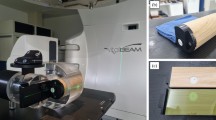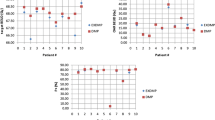Abstract
Purpose
Organ motion due to patient breathing introduces a technical challenge for dosimetry and lung tumor treatment by hadron therapy. Accurate dose distribution estimation requires patient-specific information on tumor position, size, and shape as well as information regarding the material density and stopping power of the media along the beam path. A new 4D dosimetry method was developed, which can be coupled to any motion estimation method. As an illustration, the new method was implemented and tested with a biomechanical model and clinical data.
Methods
First, an anatomical model of the lung and tumor was synthesized with deformable tetrahedral grids using computed tomography (CT) images. The CT attenuation values were estimated at the grid vertices. Respiratory motion was simulated biomechanically based on nonlinear finite element analysis. Contrary to classical image-based methods where motion is described using deformable image registration algorithms, the dose distribution was accumulated over tetrahedral meshes that are deformed using biomechanical modeling based on finite element analysis.
Results
The new method preserves the mass of the objects during simulation with an error between 1.6 and 3.6 %. The new method was compared to an existing dose calculation method demonstrating significant differences between the two approaches and overall superior performance using the new method.
Conclusion
A unified model of 4D radiotherapy respiratory effects was developed where biomechanical simulations are coupled with dose calculations. Promising results demonstrate that this approach has significant potential for the treatment for moving tumors.










Similar content being viewed by others
References
Agostinelli S, Allison J, Apostolakis J, Araujo H, Arce P, Asai M, Axen D, Banerjee S, Barrand G et al (2003) Geant4 a simulation toolkit. Nucl Instrum Methods Phys Res Sect A: Accel Spectrom Detect Assoc Equip 506(3):250–303
Al-Mayah A, Moseley J, Velec M, Brock K (2011) Toward efficient biomechanical-based deformable image registration of lungs for image-guided radiotherapy. Phys Med Biol 56(15):4701
Attene M, Falcidieno B (2006) Remesh: an interactive environment to edit and repair triangle meshes. In: IEEE international conference on shape modeling and applications, 2006 (SMI 2006). IEEE, pp 41–41
Bert C, Saito N, Schmidt A, Chaudhri N, Schardt D, Rietzel E (2007) Target motion tracking with a scanned particle beam. Med Phys 34:4768
Boldea V, Sharp GC, Jiang SB, Sarrut D (2008) 4d-ct lung motion estimation with deformable registration: quantification of motion nonlinearity and hysteresis. Med Phys 35:1008
Brock K, McShan D, Ten Haken R, Hollister S, Dawson L, Balter J (2003) Inclusion of organ deformation in dose calculations. Med Phys 30:290
Camarasu-Pop S, Glatard T, Mościcki JT, Benoit-Cattin H, Sarrut D (2010) Dynamic partitioning of gate monte-carlo simulations on egee. J Grid Comput 8(2):241–259
Castillo R, Castillo E, Guerra R, Johnson VE, McPhail T, Garg AK, Guerrero T (2009) A framework for evaluation of deformable image registration spatial accuracy using large landmark point sets. Phys Med Biol 54(7):1849
Didier AL, Villard PF, Bayle JY, Beuve M, Shariat B (2007) Breathing thorax simulation based on pleura physiology and rib kinematics. In: International conference on medical information visualisation-biomedical visualisation, 2007 (MediVis 2007). IEEE, pp 35–42
Ehrhardt J, Lorenz C (2013) 4d modeling and estimation of respiratory motion for radiation therapy.
Eom J, Xu XG, De S, Shi C (2010) Predictive modeling of lung motion over the entire respiratory cycle using measured pressure-volume data, 4dct images, and finite-element analysis. Med Phys 37:4389
Fuerst B, Mansi T, Khurd P, Zhang J, Declerck J, Boettger T, Navab N, Bayouth J, Kamen A (2012) Patient-specific finite-element simulation of respiratory mechanics for radiotherapy guidance, a first evaluation study. In: 2012 9th IEEE international symposium on biomedical imaging (ISBI). IEEE, pp 1212–1215
Jakel O, Schulz-Ertner D, Karger C, Nikoghosyan A, Debus J (2003) Heavy ion therapy: status and perspectives. Technol Cancer Res Treat 2(5):377–388
Jan S, Benoit D, Becheva E, Carlier T, Cassol F, Descourt P, Frisson T, Grevillot L, Guigues L, Maigne L et al (2011) Gate v6: a major enhancement of the gate simulation platform enabling modelling of ct and radiotherapy. Phys Med Biol 56(4):881
Kataria T, Sharma K, Subramani V, Karrthick K, Bisht SS (2012) Homogeneity index: an objective tool for assessment of conformal radiation treatments. J Med Physics/Assoc Med Phys India 37(4):207
Ladjal H, Saade J, Beuve M, Azencot J, Moreau J, Shariat B (2013) 3d biomechanical modeling of the human diaphragm based on ct scan images. In: World congress on medical physics and biomedical engineering May 26–31, 2012. Springer, Beijing, China, pp 2188–2191
Lambert J, Suchowerska N, McKenzie D, Jackson M (2005) Intrafractional motion during proton beam scanning. Phys Med Biol 50(20):4853
Lomax AJ, Böhringer T, Bolsi A, Coray D, Emert F, Goitein G, Jermann M, Lin S, Pedroni E, Rutz H et al (2004) Treatment planning and verification of proton therapy using spot scanning: initial experiences. Med Phys 31:3150
Low DA, Dempsey JF (2003) Evaluation of the gamma dose distribution comparison method. Med Phys 30:2455
Noblet V, Heinrich C, Heitz F, Armspach JP (2005) 3-d deformable image registration: a topology preservation scheme based on hierarchical deformation models and interval analysis optimization. IEEE Trans Image Process 14(5):553–566
Pedroni E, Bacher R, Blattmann H, Böhringer T, Coray A, Lomax A, Lin S, Munkel G, Scheib S, Schneider U et al (1995) The 200-mev proton therapy project at the paul scherrer institute: conceptual design and practical realization. Med Phys 22:37
Rosu M, Chetty IJ, Balter JM, Kessler ML, McShan DL, Ten Haken RK (2005) Dose reconstruction in deforming lung anatomy: dose grid size effects and clinical implications. Med Phys 32:2487
Saadé J, Didier AL, Villard PF, Buttin R, Moreau JM, Beuve M, Shariat B, et al. (2010) A preliminary study for a biomechanical model of the respiratory system. In: Proceedings of VISAPP 2010
Schneider W, Bortfeld T, Schelgel W (2000) Correlation between ct numbers and tissue parameters needed for monte carlo simulations of clinical dose distributions. Phys Med Biol 45:459–478
Schulz-Ertner D, Jäkel O, Schlegel W (2006) Radiation therapy with charged particles. In: Seminars in radiation oncology. Elsevier, Amsterdam, vol 16, pp 249–259
Seppenwoolde Y, Shirato H, Kitamura K, Shimizu S, van Herk M, Lebesque JV, Miyasaka K (2002) Precise and real-time measurement of 3d tumor motion in lung due to breathing and heartbeat, measured during radiotherapy. Int J Radiat Oncol Biol Phys 53(4):822–834
Velec M, Moseley JL, Eccles CL, Craig T, Sharpe MB, Dawson LA, Brock KK (2011) Effect of breathing motion on radiotherapy dose accumulation in the abdomen using deformable registration. Int J Radiat Oncol Biol Phys 80(1):265–272
Velec M, Moseley JL, Craig T, Dawson LA, Brock KK (2012) Accumulated dose in liver stereotactic body radiotherapy: positioning, breathing, and deformation effects. Int J Radiat Oncol Biol Phys 83(4):1132–1140
Villard PF, Beuve M, Shariat B, Baudet V, Jaillet F (2005) Simulation of lung behaviour with finite elements: influence of bio-mechanical parameters. In: Proceedings of the third international conference on medical information visualisation-biomedical visualisation, 2005 (MediVis 2005). IEEE, pp 9–14
Watson DF (1981) Computing the n-dimensional delaunay tessellation with application to voronoi polytopes. Comput J 24(2):167–172
Yushkevich PA, Piven J, Ho S, Gee JC, Gerig G (2006) User-guided 3D active contour segmentation of anatomical structures: significantly improved efficiency and reliability. Neuroimage 31(3):1116–1128
Zhong H, Siebers JV (2009) Monte carlo dose mapping on deforming anatomy. Phys Med Biol 54(19):5815
Acknowledgments
This research is supported by the ENVISION project (co-funded by the European Commission under the FP7 Collaborative Projects Grant Agreement Nr. 241851FP7), by ETOILE Research Program (PRRH/UCBL, under CPER 2007-13 funding and by the LABEX PRIMES (ANR-11-LABX-0063) , within the program “Investissements d’Avenir” (ANR-11-IDEX-0007) operated by the French National Research Agency (ANR).
Conflict of interest
Petru Manescu, Hamid Ladjal, Joseph Azencot, Michael Beuve, Etienne Testa, and Behzad Shariat declare that they have no conflict of interest.
Author information
Authors and Affiliations
Corresponding author
Rights and permissions
About this article
Cite this article
Manescu, P., Ladjal, H., Azencot, J. et al. Four-dimensional radiotherapeutic dose calculation using biomechanical respiratory motion description. Int J CARS 9, 449–457 (2014). https://doi.org/10.1007/s11548-013-0935-2
Received:
Accepted:
Published:
Issue Date:
DOI: https://doi.org/10.1007/s11548-013-0935-2




